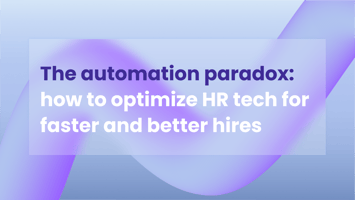Critical talent, critical growth: how to stay ahead in hiring
Critical talent, critical growth: how to stay ahead in hiring
The job market in 2025 is evolving rapidly. For companies, this brings new challenges in attracting and retaining talent. In a world where candidates are increasingly selective and competition for talent is intensifying, it is crucial for organizations to operate strategically and with a forward-thinking approach.
1. Challenges in the 2025 job market
The job market has changed significantly in recent years, and these trends are set to continue into 2025. Many job seekers face a challenging market: in 2024, 22% of professionals reported that, even after a year of searching, they still hadn’t found a new job. This sense of stagnation has caused 28% of workers to temporarily pause their job search. At the same time, competition for top-tier talent remains fierce, especially for specialized roles such as AI engineers and cybersecurity experts. These insights are based on recent LinkedIn data.
For employers, this dual challenge highlights the need for more innovative approaches. Traditional recruitment methods are no longer sufficient in a market where the best candidates have more options and higher expectations. Companies need to differentiate themselves – not only through competitive job offerings but also by creating a compelling and attractive work environment.
2. Investing in upskilling and reskilling
One of the biggest opportunities for companies in 2025 lies in developing their current and future workforce. Over half of professionals worldwide are open to exploring new industries or roles, and 25% plan to acquire new skills this year. This willingness to develop provides organizations with a unique opportunity to strengthen their talent pipeline. These trends are also highlighted in LinkedIn’s recent analyses.
Between 2022 and 2025, the pace at which professionals add new skills to their profiles has grown exponentially. Companies can capitalize on this by:
Internal training programs: Provide employees with access to courses and training to develop relevant new skills, such as artificial intelligence (AI) and data analysis.
Career progression: Create clear career paths within the organization to retain talent.
Collaborations: Partner with educational institutions or platforms to offer up-to-date training opportunities.
3. Trends: where organizations should focus
Technological innovations and societal shifts have driven significant growth in specific, high-demand roles. LinkedIn’s recent labor market analyses show that roles such as AI specialists, cybersecurity experts, and customer success managers are among the fastest-growing positions. This presents organizations with key opportunities to strengthen their competitive position.
For companies, this means:
Prioritize strategic talent: Focus on securing critical growth roles, such as AI engineers, cybersecurity specialists, and machine learning experts, that directly drive your organization’s success. Use market data and industry trends to pinpoint high-demand roles most relevant to your sector. Go beyond general recruitment by investing in specialized talent acquisition teams or headhunters who deeply understand these fields and can effectively engage top-tier candidates.
Flexible working conditions: Attract top talent by offering more than just hybrid work models—prioritize workplace flexibility as a whole. This includes remote work options, flexible hours, and personalized work arrangements that cater to individual needs. Research consistently shows that organizations prioritizing flexibility see up to 30% higher success in recruiting and retaining high-quality candidates, while also improving productivity and employee satisfaction.
Strong employer branding: Ensure your organization is known for innovation, personal development, and a focus on employee well-being. Invest in targeted marketing campaigns that highlight your unique culture and values. Leverage employees as brand ambassadors to provide potential candidates with an authentic view of your organization.
Partnering with tech and educational institutions: Leverage external expertise and tools to quickly integrate emerging trends like AI and automation into your operations. Consider strategic partnerships with technical universities and training programs to gain access to highly skilled talent and collaboratively address future skill demands.
By focusing on these trends, companies can not only compete in today’s labor market but also take a leading role in their industry. This requires a proactive, data-driven approach that combines technological and human insights.
4. Conclusion: the winning company
Successful companies in 2025 are those that adapt flexibly and proactively to the rapidly changing labor market. By recruiting strategically, investing in upskilling, and focusing on innovation, organizations can attract and retain top talent.
The key lies in a forward-looking approach that not only addresses the challenges of today but also prepares for the opportunities of tomorrow. By investing in both people and processes, companies can remain relevant and competitive in a dynamic market.
Got a question or want to know how we can help? Reach out to Jasper – he’s here to help you every step of the way! ✨



